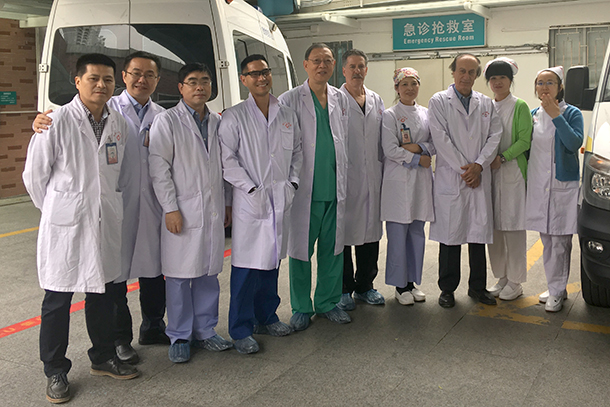A hospital in China has received national recognition for its trauma and critical care, after joining physicians from Keck Medicine of USC to set up an American-style trauma center based on Los Angeles County + USC Medical Center.
Nanshan Hospital in Shenzhen, China, has received a top national award for its performance improvement in trauma and critical care. The program has so impressed political and business leaders in Nanshan that it will be expanded across the city, which has an estimated 18 million residents.
The collaboration started nearly four years ago, when Tom Jackiewicz, MPH, senior vice president and CEO of Keck Medicine, signed an agreement with the leadership of Nanshan Hospital to help them set up a modern trauma and critical care program. LAC+USC began hosting rotating teams of surgeons, emergency physicians and nurses from Nanshan for three to six months at a time so they could see the inner workings of a Level I trauma center.
“I know from experience that we have a lot to learn from each other,” said Jackiewicz, who also serves as president of the Global Health Insight Network (GHIN). “Despite different health care systems, fundamentally we share the same goal: we all want to provide the best care for our communities.”
One of the most remarkable advances Nanshan Hospital made with the help of the Keck Medicine team was cutting the time it takes to evaluate trauma patients in half.
“Time is the most precious commodity for a severely injured patient,” explained Demetrios Demetriades, MD, PhD, professor of surgery at the Keck School of Medicine of USC and chief of trauma, emergency surgery and surgical critical care. “With severe trauma, for every 10 minutes you delay definitive treatment, mortality goes up by 10 percent.”
Through their work with USC, the Nanshan team reorganized their trauma program and implemented new trauma team activation procedures. Now an incoming patient is met and evaluated by multiple caregivers in a streamlined process, resulting in a dramatic improvement in outcomes. The Nanshan team also started an extensive trauma registry. They now maintain detailed records of every patient admitted, monitor outcomes and review all complications and deaths to ensure that the hospital takes corrective action and continues to improve.
Once a year, Keck Medicine sends two trauma surgeons and one emergency physician to Nanshan, where they hold a joint Trauma, Emergency Surgery and Critical Care symposium that is attended by top medical and political leaders all over China. After the conference, the Keck Medicine team spends several days at the hospital to consult on quality improvement. This year, Demetriades went with Kenji Inaba, MD, associate professor of surgery (clinical scholar) and vice chair of the Department of Surgery; Carl R. Chudnofsky, MD, chair and professor of clinical emergency medicine; Elizabeth Beale, MD, assistant professor of clinical medicine; and research assistant professor and program coordinator Jay Zhu, MD.
“Between the time I first went in 2015 and this last trip, there has been a tremendous advancement in the trauma care provided to the people of Nanshan,” Inaba said.
That improvement has been widely appreciated, Demetriades said. During the team’s most recent visit in December of 2017, the physicians learned that Nanshan’s program so impressed regional and national leaders that modernization and expansion of the country’s trauma centers has been made a national priority.
China’s science education television channel, with a viewership of about 300 million people, was also intrigued by the program, Demetriades added. Producers sent a crew to Nanshan to interview and shadow the Keck Medicine team for three days, and a documentary about their philosophy and techniques is set to air this spring.
— Lex Davis


